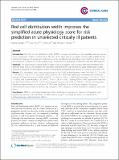Red cell distribution width improves the simplified acute physiology score for risk prediction in unselected critically ill patients
Author(s)
Hunzike, Sabina; Celi, Leo Anthony G.; Lee, Joon; Howell, Michael D.
Downloadcc11351.pdf (387.1Kb)
PUBLISHER_CC
Publisher with Creative Commons License
Creative Commons Attribution
Terms of use
Metadata
Show full item recordAbstract
Introduction: Recently, red cell distribution width (RDW), a measure of erythrocyte size variability, has been shown to be a prognostic marker in critical illness. The aim of this study was to investigate whether adding RDW has the potential to improve the prognostic performance of the simplified acute physiology score (SAPS) to predict short- and long-term mortality in an independent, large, and unselected population of intensive care unit (ICU) patients. Methods: This observational cohort study includes 17,922 ICU patients with available RDW measurements from different types of ICUs. We modeled the association between RDW and mortality by using multivariable logistic regression, adjusting for demographic factors, comorbidities, hematocrit, and severity of illness by using the SAPS. Results: ICU-, in-hospital-, and 1-year mortality rates in the 17,922 included patients were 7.6% (95% CI, 7.2 to 8.0), 11.2% (95% CI, 10.8 to 11.7), and 25.4% (95% CI, 24.8 to 26.1). RDW was significantly associated with in-hospital mortality (OR per 1% increase in RDW (95%CI)) (1.14 (1.08 to 1.19), P < 0.0001), ICU mortality (1.10 (1.06 to 1.15), P < 0.0001), and 1-year mortality (1.20 (95% CI, 1.14 to 1.26); P < 0.001). Adding RDW to SAPS significantly improved the AUC from 0.746 to 0.774 (P < 0.001) for in-hospital mortality and 0.793 to 0.805 (P < 0.001) for ICU mortality. Significant improvements in classification of SAPS were confirmed in reclassification analyses. Subgroups demonstrated robust results for gender, age categories, SAPS categories, anemia, hematocrit categories, and renal failure. Conclusions: RDW is a promising independent short- and long-term prognostic marker in ICU patients and significantly improves risk stratification of SAPS. Further research is needed the better to understand the pathophysiology underlying these effects.
Date issued
2012-05Department
Harvard University--MIT Division of Health Sciences and TechnologyJournal
Critical Care
Publisher
BioMed Central Ltd.
Citation
Hunziker, Sabina et al. “Red Cell Distribution Width Improves the Simplified Acute Physiology Score for Risk Prediction in Unselected Critically Ill Patients.” Critical Care 16.3 (2012): R89. Web.
Version: Final published version
ISSN
1364-8535
1875-7081